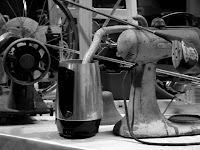

The above images are by two different students who developed a series of drawings thematically connected. The two images with telephone poles by Preot Buxton (there are others I couldn't get posted) were the result of his wanderings around the city with sketchbook and charcaol, looking for abstract shapes in the urban industrial landscape. He climbed on and off derelict bridges, and in and out of abandoned warehouses searching for the inspirational forms that would prompt him to return to his studio to develop the larger drawings. These two are 36" x 24" and combine charcoal, ink, and gesso.
Eric Pike developed the series of still life drawings that combined self portraits with objects that had autobiographical references. Eric was a graphic design student (not at IUS) so he had a clear interest in the design of the page and used bold shapes to activate the space. These images are done in charcoal and measure roughly 36" x 40".
Both of these students developed a series allowing one image to grow from the other sequentially, both in process and formal elements. They also both had a good grasp of the positive/negative relationships in their images. One does not detract from the other and the integration of the positive and negative create unified images. Don't lose focus on your negative areas in the planning and execution of your series so you don't get caught later on trying to figure out what to do with your "backgrounds".
I'm looking forward to seeing where we are at the midpoint of the summer session. See you in the morning.








